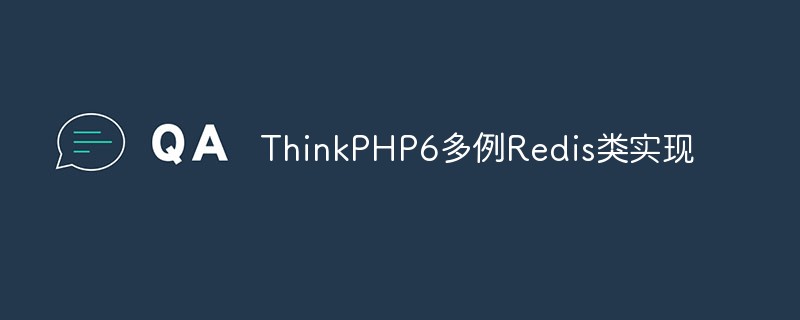ThinkPHP6의 여러 Redis 클래스 구현 정보
- 藏色散人앞으로
- 2020-09-08 09:50:365888검색
다음 튜토리얼 칼럼인 thinkphp에서는 ThinkPHP6의 Redis 클래스 구현에 대한 여러 예제를 소개하겠습니다. 도움이 필요한 친구들에게 도움이 되길 바랍니다!

Thinkphp 프로젝트에서 Redis 다중 라이브러리 싱글톤 작업 클래스를 캡슐화합니다
1 작업 전 준비
phpredis 모듈이 설치되지 않은 경우 실행합니다. 그것 먼저
composer require predis/predis
2. Redis 연결 정보 구성
appconfigcache.php에서 구성
'redis' => [
// 驱动方式
'type' => 'redis',
// 连接地址
'host' => Env::get('redis.host'),
// 端口
'port' => Env::get('redis.port'),],자세한 구성 참조
/**
* 配置参数
* @var array
*/protected $options = [
'host' => '127.0.0.1',
'port' => 6379,
'password' => '',
'select' => 0,
'timeout' => 0,
'expire' => 0,
'persistent' => false,
'prefix' => '',
'tag_prefix' => 'tag:',
'serialize' => [],];.env
[REDIS]host = 127.0.0.1 port = 6379
에서 연결 정보 구성
appcommon 아래에 파일을 생성합니다. Redis.php
<?phpnamespace app\common;use think\facade\Config;use think\cache\driver\redis as ThinkRedis;class Redis extends ThinkRedis{
/**
* @var int
*/
protected $hash;
/**
* @var array
*/
protected static $instance = [];
/**
* Redis constructor.
* @param $db
*/
private function __construct($db)
{
$options = Config::get('cache.stores.redis');
$options['select'] = $db;
$this->hash = $db;
$this->options = array_merge($this->options, $options);
parent::__construct();
}
private function __clone()
{
}
/**
* @param int $db
* @return \Predis\Client|\Redis
*/
public static function instance($db = 0)
{
if (! isset(self::$instance[$db])) {
self::$instance[$db] = new self($db);
}
return self::$instance[$db];
}
public function __destruct()
{
self::$instance[$this->hash]->close();
unset(self::$instance[$this->hash]);
}}4.사용방법
use app\common\Redis; $redis = Redis::instance(4); $redis->hSet('user:1', 'userName', 'admin'); Redis::instance(1)->hSet('user', 'name', 'admin1'); Redis::instance(2)->hSet('user', 'name', 'admin2'); Redis::instance(3)->hSet('user', 'name', 'admin3');
자세한 사용방법은 redis 명령어 매뉴얼
을 참고하세요.위 내용은 ThinkPHP6의 여러 Redis 클래스 구현 정보의 상세 내용입니다. 자세한 내용은 PHP 중국어 웹사이트의 기타 관련 기사를 참조하세요!
성명:
이 기사는 csdn.net에서 복제됩니다. 침해가 있는 경우 admin@php.cn으로 문의하시기 바랍니다. 삭제

